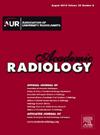Comparing Habitat, Radiomics, and Fusion Models for Predicting Micropapillary/Solid Components in Stage I Lung Adenocarcinoma
IF 3.9
2区 医学
Q1 RADIOLOGY, NUCLEAR MEDICINE & MEDICAL IMAGING
引用次数: 0
Abstract
Rationale and Objectives
To comprehensively compare habitat, radiomics, and fusion models for the preoperative prediction of micropapillary/solid (MP/S) status in stage I lung adenocarcinoma (LAC).
Materials and Methods
In this retrospective study, we enrolled 345 patients postoperatively diagnosed with stage I LAC from two medical centers, dividing them into training (n = 207), internal validation (n = 69), and external validation (n = 69) cohorts. Radiomics model (RM) was developed using CT images of the primary tumor. Habitat model (HM) was built by analyzing intra-tumor subregions identified via unsupervised K-means clustering algorithm. Fusion model employed two integration strategies as follows: feature-based pre-fusion model (pre-FM) and decision-based post-fusion model (post-FM). The predictive performance of all models was comprehensively evaluated by area under the curve (AUC) and integrated discrimination improvement (IDI). Additionally, correlations between clustering and radiomics features were analyzed with Spearman’s correlation analysis.
Results
The HM demonstrated superior predictive performance compared to the RM in the training cohort (AUC: 0.900 vs. 0.876, p = 0.252). The pre-FM consistently outperformed the HM and RM across all study cohorts (AUC: 0.843–0.914 vs. 0.802–0.900 and 0.841–0.876, p = 0.041–0.484 and 0.011–0.924, respectively). The post-FM further enhanced predictive performance, as evidenced by the highest AUCs in the training and internal validation cohorts (AUC: 0.952 vs. 0.862–0.914, p = 0.001–0.116; 0.850 [0.724–0.922] vs. 0.770–0.843, p = 0.102–0.922). and IDI values (14.2%–36.4% increase). Additionally, clustering and radiomics features displayed a higher number of correlated feature pairs in the MP/S (+) group than MP/S (-) group.
Conclusion
The post-FM, integrating clustering signature, radiomics signature, and clinical characteristics, has been established as a reliable predictor for MP/S status in stage I LAC.
比较生境、放射组学和融合模型预测I期肺腺癌的微乳头状/固体成分。
理由和目的:综合比较I期肺腺癌(LAC)术前微乳头状/固体(MP/S)状态预测的栖息地、放射组学和融合模型。材料和方法:在这项回顾性研究中,我们从两个医疗中心招募了345例术后诊断为I期LAC的患者,将他们分为培训组(n=207)、内部验证组(n=69)和外部验证组(n=69)。利用原发肿瘤的CT图像建立放射组学模型(RM)。通过分析无监督K-means聚类算法识别的肿瘤内亚区,建立生境模型(HM)。融合模型采用两种融合策略:基于特征的融合前模型(pre-FM)和基于决策的融合后模型(post-FM)。采用曲线下面积(AUC)和综合判别改进(IDI)对各模型的预测性能进行综合评价。此外,用Spearman相关分析分析聚类与放射组学特征之间的相关性。结果:与训练队列中的RM相比,HM表现出更好的预测性能(AUC: 0.900比0.876,p=0.252)。在所有研究队列中,预调剂的效果始终优于HM和RM (AUC: 0.843-0.914 vs. 0.802-0.900和0.841-0.876,p分别=0.041-0.484和0.011-0.924)。训练组和内部验证组的AUC最高(AUC: 0.952 vs. 0.862-0.914, p=0.001-0.116;0.850(0.724 - -0.922)和0.770 - -0.843,p = 0.102 - -0.922)。IDI值增加14.2% ~ 36.4%。此外,聚类和放射组学特征在MP/S(+)组中显示出比MP/S(-)组更多的相关特征对。结论:fm后,综合聚类特征、放射组学特征和临床特征,已被确立为I期LAC MP/S状态的可靠预测指标。
本文章由计算机程序翻译,如有差异,请以英文原文为准。
求助全文
约1分钟内获得全文
求助全文
来源期刊

Academic Radiology
医学-核医学
CiteScore
7.60
自引率
10.40%
发文量
432
审稿时长
18 days
期刊介绍:
Academic Radiology publishes original reports of clinical and laboratory investigations in diagnostic imaging, the diagnostic use of radioactive isotopes, computed tomography, positron emission tomography, magnetic resonance imaging, ultrasound, digital subtraction angiography, image-guided interventions and related techniques. It also includes brief technical reports describing original observations, techniques, and instrumental developments; state-of-the-art reports on clinical issues, new technology and other topics of current medical importance; meta-analyses; scientific studies and opinions on radiologic education; and letters to the Editor.
 求助内容:
求助内容: 应助结果提醒方式:
应助结果提醒方式:


